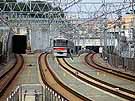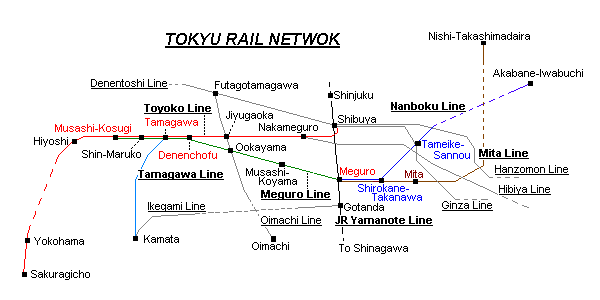
Completed four-track section between Denenchofu and Tamagawa. A Tokyu series 3000 is emerging from half-underground Denenchofu station. Subway through trains use inner two tracks.

Completed four-track section between Denenchofu and Tamagawa. A Tokyu series 3000 is emerging from half-underground Denenchofu station. Subway through trains use inner two tracks.
|
By Hiroshi Naito
This must be the hottest news in this decade as to the Tokyo rail transit network.
The Eidan Subway's Nanboku (North-south) line inaugurated its final
stage of line extension between Tameike-Sannou and Meguro, 5.2 km,
September 26th, achieving linkage to the Tokyu Electric Railway's
Meguro Line. At the same time, Tokyo Municipal Subway's (Toei Subway)
Mita Line southern extension was completed to Shirokane-Takanwa on thr
route of the Nanboku Line's extended segment, accomplishing another
connection to the Tokyu Meguro Line with trackage rights over the
Nanboku Line to Meguro under a class II operation license. With the
linkage at Meguro, the three operators, Eidan Subway, Toei Subway and
Tokyu Electric Railway, commenced through operation between
Musashi-Kosugi on the Toyku Toyoko Line and Akabane-Iwabuchi, and
between Musashi-Kosugi and Nishi-Takashimadaira, (respectively the
northern ends of the Nanboku Line and the Mita Line).

As well as the Meguro Line reconstruction, the Toyoko Line's
Denenchofu to Tamagawa and further to Musashi-Kosugi segment has been
upgraded to a four-track line to accommodate through subway trains.
Now, the Toyoko Line trains and the subway through trains are busily
running on this section paralleling each other using respective
dedicated double tracks.
The fleet for the new subway through operation via the Meguro Line
consists of Tokyu series 3000, Eidan series 9000 and Toei series 6300,
which are all 6-car 20 m class train sets. The Tokyu series 3000 was
specially developed for the new service, as opposed to the former
Mekama Line fleet of 4-car 18 m class series 7200 and 7400. The new
Tamagawa Line operates with 3-car series 7700, being shrunk from the
former 4-car operation. With the withdrawal of the series 7200 and
7400, most of which are expected to be sold to other private railways,
18 m class stock has completely disappeared from the Tokyu fleet.
A new feature applied to the subway Mita Line and Tokyu Meguro Line
is platform doors that protect passengers on the platforms and thus
allow safe one-man operation. These three lines now operate without a
guard (or a conductor) on board (the Nanboku Line was originally fitted
with platform screens and doors). Unlike platform screen doors common
on fully automated driverless railways, the doors are short in height,
about 1300 mm, which is advantageous to the passengers as to reduce
feelings of claustrophobia. Another feature supporting safe one-man
operation is train-borne platform CCTV display monitors installed in
the cab to provide the train driver with clear vision over platforms.
At each station stop, visually ensuring passengers safety on the
platform by means of the display monitors, the train driver manually
opens and closes the train doors by pressing the button mounted on the
control. The platform doors simultaneously operate in response to the
train driver command conveyed through a train to a wayside
communication device (transponder).
As well as the track upgrading, the Meguro Line was resignaled with
a cab-signaled ATC system. Also added to the trains in the through
service fleet is an automatic station stop controller to ensure
accurate stopping at each station to fulfill correspondence between
train doors and platform doors. Train drivers manually operate a train,
but do not have to worry about braking for station stops at each
station, as the transponders mentioned above also function as part of
the automatic station stop control system, with some ground devices
installed in the approach to the station platform and in the track at
the platform, acting as the stopping target makers.
The commencement of the new through service between Tokyu and the
two subway lines has caused a great impact on the passenger traffic
flow from the areas along the Toyoko Line, mostly in Kawasaki and
Yokohama cities west of Tokyo, towards the center of downtown Tokyo,
thus easing passenger congestion on the Toyoko Line traffic to
Shibuya/Tokyo. The Toyoko Line's reconstruction work to upgrade the
current double track to four-track still continues westwards up to
Hiyoshi, about 2.8 km west of Musashi-Kosugi, expecting to extend the
new subway through operation. With a new subway line under construction
in Yokohama, to which the Toyoko Line is to be connected at Yokohama
station in three years, the circumstances of the Tokyu Toyoko Line, one
of the busiest commuter lines in the Tokyo and Yokohama area, are
greatly evolving.
All photos were taken by the author in October 2000.